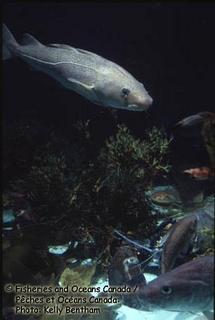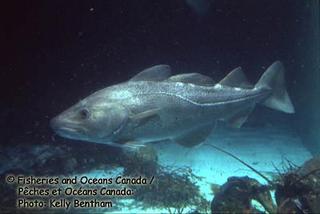Wednesday, September 21, 2005
Cod WASH? I can't see a difference can you see a difference?
Cod, Atlantic | Gadus morhua | Newfoundland and Labrador population

Status: Endangered
Last Examination and Change: May 2003 (Reassigned)
Canadian Occurrence: Atlantic Ocean
Status Criteria: A2b
(image placeholder)
Reason for Designation: Cod in the inshore and offshore waters of Labrador and northeastern Newfoundland, including Grand Bank, having declined 97% since the early 1970s and more than 99% since the early 1960s, are now at historically low levels. There has been virtually no recovery of either the abundance or age structure of cod in offshore waters since the moratoria imposed in 1992 and 1993. Threats to persistence include fishing (now halted), predation by fish and seals, and natural and fishing-induced changes to the ecosystem.
Status History: The species was considered a single unit and designated Special Concern in April 1998. When the species was split into separate populations in May 2003, the Newfoundland and Labrador population was designated Endangered. Last assessment based on an update status report.
Cod, Atlantic | Gadus morhua | Laurentian North population

Status: Threatened
Last Examination and Change: May 2003 (Reassigned)
Canadian Occurrence: Atlantic Ocean
Status Criteria: Met criterion for Endangered, A2b, but designated Threatened because stocks within this unit have displayed an ability to recover from overfishing and conservation measures have been instituted.
(image placeholder)
Reason for Designation: Cod in the Northern Gulf of St. Lawrence and along the south coast of Newfoundland comprise an assemblage of stocks within which there is considerable mixing. They are currently at low levels as a group and overall have declined by about 80% over the past thirty years. However, there is evidence that current levels of abundance are not unprecedented for cod along the south coast of Newfoundland, and the population there has been stable since 1974. Threats to persistence include fishing (now halted in the Northern Gulf), predation by fish and seals, and natural and fishing-induced changes to the ecosystem.
Status History: The species was considered a single unit and designated Special Concern in April 1998. When the species was split into separate populations in May 2003, the Laurentian North population was designated Threatened. Last assessment based on an update status report.
Cod, Atlantic | Gadus morhua | Arctic population

Status: Special Concern
Last Examination and Change: May 2003 (Reassigned)
Canadian Occurrence: Arctic Ocean
Status Criteria: Not applicable
(image placeholder)
Reason for Designation: Cod in Arctic waters occur mostly in a few coastal salt lakes, and numbers of adults may be no more than a few thousand. Uncertainty with respect to the actual number of locales and populations makes it difficult to assign any higher status, but the known populations are sensitive to human activities. Poorly regulated fishing is a potential threat.
Status History: The species was considered a single unit and designated Special Concern in April 1998. When the species was split into separate populations in May 2003, the Arctic population was designated Special Concern. Last assessment based on an update status report.
Cod, Atlantic | Gadus morhua | Maritimes population

Status: Special Concern
Last Examination and Change: May 2003 (Reassigned)
Canadian Occurrence: Atlantic Ocean
Status Criteria: Not applicable
(image placeholder)
Reason for Designation: Cod in the Southern Gulf of the St. Lawrence, across the Scotian Shelf and into the Gulf of Maine comprise a heterogeneous assemblage of stocks that are at low levels of abundance as a group. These levels are not unprecedented for the cod in the Southern Gulf, Southwest Scotian shelf, Bay of Fundy and George’s Bank, but those on the Eastern Scotian Shelf, are at historic lows and have continued to decline in the absence of directed fishing. Overall, cod in the entire region have declined 14% in the past 30 years, and have demonstrated a sensitivity to human activities. Threats to persistence include directed fishing, bycatch in other fisheries, natural predation, and natural and fishing-induced changes to the ecosystem.
Status History: The species was considered a single unit and designated Special Concern in April 1998. When the species was split into separate populations in May 2003, the Maritimes population was designated Special Concern. Last assessment based on an update status report.
Why should NL be the only ones who have to suffer at the expence of foreign overfishing, due to the lack of control by Canada and creative geneology assignments?
Was going to call this Cod Geneology.

Status: Endangered
Last Examination and Change: May 2003 (Reassigned)
Canadian Occurrence: Atlantic Ocean
Status Criteria: A2b
(image placeholder)
Reason for Designation: Cod in the inshore and offshore waters of Labrador and northeastern Newfoundland, including Grand Bank, having declined 97% since the early 1970s and more than 99% since the early 1960s, are now at historically low levels. There has been virtually no recovery of either the abundance or age structure of cod in offshore waters since the moratoria imposed in 1992 and 1993. Threats to persistence include fishing (now halted), predation by fish and seals, and natural and fishing-induced changes to the ecosystem.
Status History: The species was considered a single unit and designated Special Concern in April 1998. When the species was split into separate populations in May 2003, the Newfoundland and Labrador population was designated Endangered. Last assessment based on an update status report.
Cod, Atlantic | Gadus morhua | Laurentian North population

Status: Threatened
Last Examination and Change: May 2003 (Reassigned)
Canadian Occurrence: Atlantic Ocean
Status Criteria: Met criterion for Endangered, A2b, but designated Threatened because stocks within this unit have displayed an ability to recover from overfishing and conservation measures have been instituted.
(image placeholder)
Reason for Designation: Cod in the Northern Gulf of St. Lawrence and along the south coast of Newfoundland comprise an assemblage of stocks within which there is considerable mixing. They are currently at low levels as a group and overall have declined by about 80% over the past thirty years. However, there is evidence that current levels of abundance are not unprecedented for cod along the south coast of Newfoundland, and the population there has been stable since 1974. Threats to persistence include fishing (now halted in the Northern Gulf), predation by fish and seals, and natural and fishing-induced changes to the ecosystem.
Status History: The species was considered a single unit and designated Special Concern in April 1998. When the species was split into separate populations in May 2003, the Laurentian North population was designated Threatened. Last assessment based on an update status report.
Cod, Atlantic | Gadus morhua | Arctic population

Status: Special Concern
Last Examination and Change: May 2003 (Reassigned)
Canadian Occurrence: Arctic Ocean
Status Criteria: Not applicable
(image placeholder)
Reason for Designation: Cod in Arctic waters occur mostly in a few coastal salt lakes, and numbers of adults may be no more than a few thousand. Uncertainty with respect to the actual number of locales and populations makes it difficult to assign any higher status, but the known populations are sensitive to human activities. Poorly regulated fishing is a potential threat.
Status History: The species was considered a single unit and designated Special Concern in April 1998. When the species was split into separate populations in May 2003, the Arctic population was designated Special Concern. Last assessment based on an update status report.
Cod, Atlantic | Gadus morhua | Maritimes population

Status: Special Concern
Last Examination and Change: May 2003 (Reassigned)
Canadian Occurrence: Atlantic Ocean
Status Criteria: Not applicable
(image placeholder)
Reason for Designation: Cod in the Southern Gulf of the St. Lawrence, across the Scotian Shelf and into the Gulf of Maine comprise a heterogeneous assemblage of stocks that are at low levels of abundance as a group. These levels are not unprecedented for the cod in the Southern Gulf, Southwest Scotian shelf, Bay of Fundy and George’s Bank, but those on the Eastern Scotian Shelf, are at historic lows and have continued to decline in the absence of directed fishing. Overall, cod in the entire region have declined 14% in the past 30 years, and have demonstrated a sensitivity to human activities. Threats to persistence include directed fishing, bycatch in other fisheries, natural predation, and natural and fishing-induced changes to the ecosystem.
Status History: The species was considered a single unit and designated Special Concern in April 1998. When the species was split into separate populations in May 2003, the Maritimes population was designated Special Concern. Last assessment based on an update status report.
Why should NL be the only ones who have to suffer at the expence of foreign overfishing, due to the lack of control by Canada and creative geneology assignments?
Was going to call this Cod Geneology.
Subscribe to Comments [Atom]
